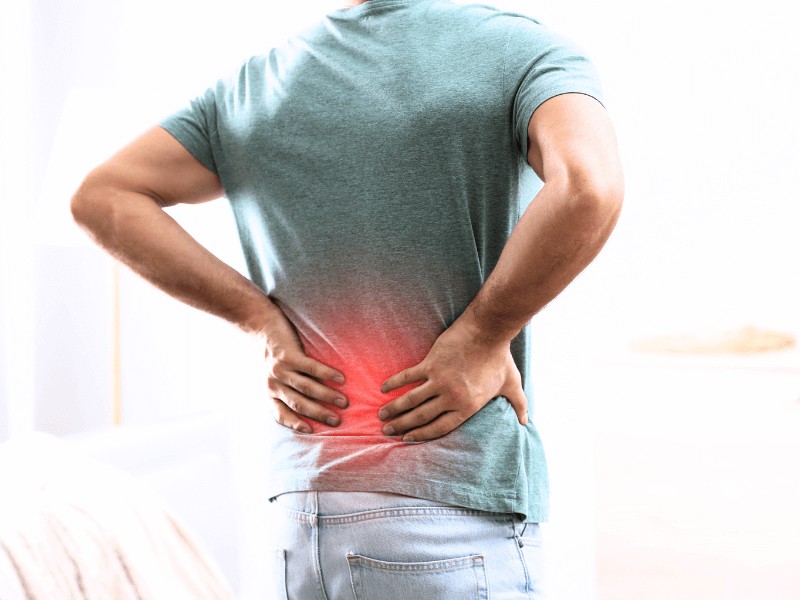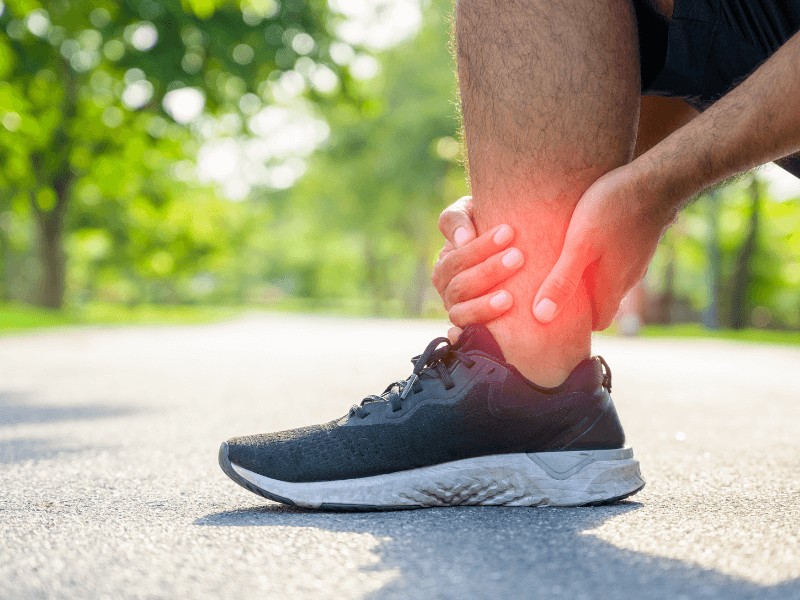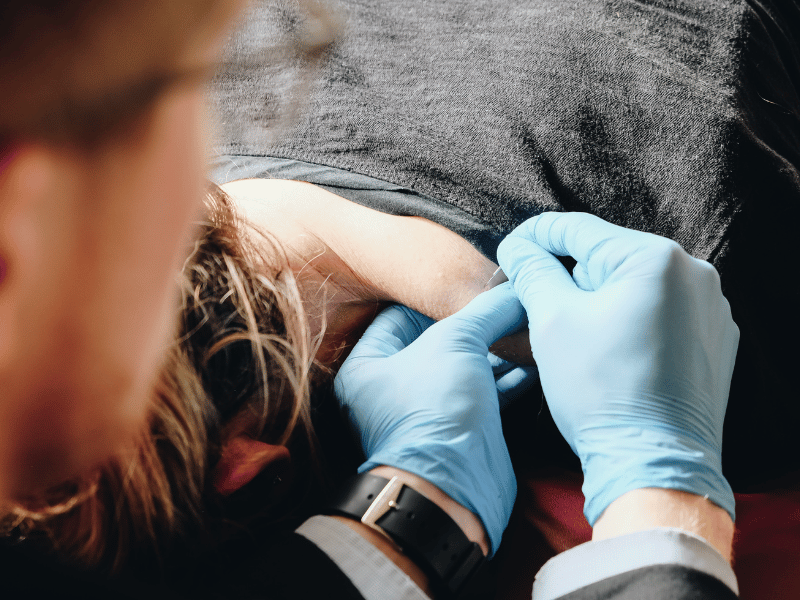Radiculopathy Relief: How Physical Therapy Can Get You Back to Feeling Your Best
If you’ve experienced sharp, radiating pain from your neck or lower back down into your arms or legs, it’s normal to feel worried and quickly research what “radiculopathy” means online.
This type of radiating pain is often referred to as radiculopathy, which can occur when a nerve exiting your spine becomes compressed or irritated. It can subsequently lead to pain, tingling, numbness, or weakness along the affected nerve pathway.
Radiculopathy is a fairly common condition, especially as we age. Research shows that cervical radiculopathy (located in the neck and/or arms) occurs in about 83 out of 100,000 people annually. Lumbar radiculopathy (located in the lower back and/or legs) is even more prevalent and affects roughly 3% to 5% of adults at some point in their lives.
Radiculopathy can significantly impact your quality of life—but the good news is that relief is possible.
This page will walk you through everything you should know about both cervical and lumbar radiculopathy, including their causes, common symptoms, and the most effective treatment options. You’ll also learn how physical therapy can play a key role in your recovery.
If you’ve been struggling with nerve pain and are looking for solutions, keep reading—you’re in the right place.
What is Radiculopathy?
Radiculopathy is a condition that occurs when a nerve root in the spine becomes compressed or irritated, which causes pain, numbness, tingling, or weakness along the path of the nerve. Since nerve roots branch off from the spinal cord and extend throughout your body, when one of these nerves is pinched, your symptoms can radiate far from the site of the compression. The most common areas affected are the neck (as in cervical radiculopathy) and lower back (as in lumbar radiculopathy). Although radiculopathy can also occur in the middle back (as in thoracic radiculopathy), this is less frequent.
Symptoms of Radiculopathy
Radiculopathy can manifest in a variety of ways, depending on the location of the affected nerve root. While some people may experience mild discomfort, others might struggle with more severe pain and mobility issues. Symptoms typically occur along the path of the pinched nerve and can radiate into the arms, hands, legs, or feet. Below, we’ll explore the potential symptoms for both cervical (upper body) and lumbar (lower body) radiculopathy, which tend to vary based on where the nerve compression occurs.
Cervical Radiculopathy Symptoms
When a nerve in your neck is compressed, it can lead to a range of symptoms that affect the upper body:
- Pain that radiates from the neck into the shoulder, arm, hand, or fingers.
- Sharp, burning, or shooting pain that may increase with certain neck movements, such as turning your head or looking down.
- Tingling or numbness that may occur in the arm, hand, or fingers, sometimes like a “pins and needles” sensation.
- Weakness in the muscles of the shoulder, arm, or hand, which can sometimes affect your ability to grip, lift, or handle objects.
- Neck stiffness or discomfort, which may worsen when trying to perform activities like driving or sitting for extended periods.
Lumbar Radiculopathy Symptoms
When nerve roots in your lower back are compressed, symptoms typically affect the lower body. Common signs of lumbar radiculopathy are:
- Lower back pain that may radiate into the buttocks, thigh, calf, or foot.
- Sciatica, or sharp, shooting pain that travels down the back of the leg.
- Numbness or tingling that may occur in the leg or foot, sometimes creating a feeling of instability when walking.
- Muscle weakness in the leg, foot, or toes making it difficult to stand on your toes or lift your foot.
- Increased pain with prolonged sitting or standing, since these positions may increase pressure on the affected nerve.
- Difficulty with walking or balance, potentially leading to altered gait or the feeling that your legs are giving out.
What Causes Radiculopathy?
Radiculopathy can develop for a variety of reasons, and certain factors may increase your risk of experiencing symptoms. While these factors are commonly linked to radiculopathy, they don’t directly cause it in every case.
Cervical Radiculopathy Causes
- Degenerative disc disease: As we age, the discs between our vertebrae in the spine can wear, potentially leading to disc herniation or bone spurs that compress nearby nerves.
- Herniated disc: A cervical disc can sometimes rupture or bulge, pressing on a nerve root and causing radiating pain.
- Bone spurs or osteophytes: Over time, our bones in the spine may develop small projections, which can narrow the spaces through which the nerves travel and lead to compression.
- Injury or trauma: Whiplash or sudden impacts from car accidents, falls, or sports injuries can irritate cervical nerves.
- Repetitive motion: Activities that involve repetitive neck movements or prolonged poor posture (such as looking down at a phone or computer) can place added strain on the cervical spine and potentially contribute to symptoms.
- Spinal stenosis: This condition, characterized by a narrowing of the spinal canal, can sometimes lead to nerve compression in older adults.
Lumbar Radiculopathy Causes
- Herniated disc: Similarly, discs can also bulge or rupture in the lower back, leading to nerve compression that often results in sciatica or other leg-related symptoms.
- Degenerative changes: With age, the lumbar spine can undergo changes that can sometimes lead to disc degeneration, reducing the space between vertebrae.
- Spondylolisthesis: This condition occurs when a lumbar vertebra slips forward onto the bone below it, potentially compressing lumbar nerves.
- Spinal stenosis: Similar to cervical radiculopathy, a narrowing of the spinal canal in the lumbar region can sometimes lead to symptoms during prolonged standing or walking.
- Obesity: Carrying excess weight can place additional strain on one’s lower back, potentially increasing the likelihood of symptoms
- Physical strain or repeated motions: Jobs or activities that involve repetitive lifting, twisting, or bending can place excessive stresses on the lumbar spine and increase the risk of disc injury or nerve compression.
Treatment Options for Radiculopathy
The best treatment for your specific symptoms depends on many factors. While some cases can resolve with conservative treatment, more severe or persistent cases may require advanced interventions. Let’s explore various treatment options for both cervical and lumbar radiculopathy, ranging from non-invasive therapies to surgical procedures:
Cervical Radiculopathy Treatments
- Physical Therapy: Often the first-line of treatment, physical therapy focuses on reducing pain, improving mobility, and strengthening your muscles that support the neck and upper back. Physical therapists who specialize in radiculopathy can use manual techniques, guided exercises, and posture education to relieve pressure on the affected nerve. This non-invasive approach is effective for many people and can help prevent the need for more aggressive treatments.
- Medications: Over-the-counter anti-inflammatory drugs (NSAIDs) may help reduce inflammation and alleviate pain. In some cases, prescription medications like muscle relaxants or oral corticosteroids may be recommended by your physician to manage more intense symptoms.
- Steroid Injections: If recommended by your physician, corticosteroid injections are sometimes used to reduce inflammation and swelling around the affected nerve. This can provide temporary pain relief and improve mobility, allowing you to engage more fully in physical therapy or other treatments.
- Lifestyle Modifications: Improving posture, limiting activities that aggravate symptoms, or making ergonomic changes to your workspace can also help alleviate symptoms.
- Surgery: In cases where more conservative treatment options don’t provide sufficient relief, surgery may be considered.
Lumbar Radiculopathy Treatments
- Physical Therapy: Physical therapy also plays a crucial role in treating lumbar radiculopathy. Physical therapists guide patients through specific exercises to strengthen core muscles and improve spinal stability. This treatment can also help restore mobility and flexibility in the lower back and legs.
- Medications: Similar to cervical radiculopathy, NSAIDs are often used to reduce inflammation in the lower back. In more severe cases, physicians may prescribe muscle relaxants, nerve pain medications, or short courses of corticosteroids to manage acute flare-ups.
- Steroid Injections: Epidural steroid injections can sometimes provide relief by reducing inflammation in the lower back and around the nerve roots. While not a permanent solution, these injections can make it easier to participate in physical therapy or manage day-to-day activities.
- Surgery: If conservative measures fail to relieve symptoms or if nerve damage is severe, surgical intervention may be required.
How Physical Therapy can help with Radiculopathy
As described briefly above, physical therapy is a highly effective and non-invasive treatment option for managing radiculopathy, whether it’s affecting your neck or lower back.
A skilled physical therapist will work with you to create a personalized treatment plan tailored to your specific symptoms, needs, and lifestyle. The goal is to not only reduce pain but also address the underlying issues causing nerve compression and prevent future flare-ups.
During physical therapy for radiculopathy, you can expect hands-on manual therapy techniques designed to relieve pressure on your affected nerves. These techniques may include soft tissue mobilization, gentle spinal manipulation, or traction to improve spinal alignment and decompress the irritated nerve roots. Your PT may also work on improving your posture and desk ergonomics. Especially in the case of cervical radiculopathy, correcting the way you sit, stand, and move your neck can make a significant difference in relieving symptoms.
Exercise is another crucial component of physical therapy. Your therapist will guide you through targeted muscle strengthening exercises aimed at stabilizing your spine. For cervical radiculopathy, this might involve strengthening the neck and shoulder muscles to provide better support and reduce strain on the spine. For lumbar radiculopathy, core stabilization exercises are key to improving the overall health and mobility of your lower back. Stretching exercises may also be included to increase flexibility in tight muscles that could be contributing to symptoms. Your therapist should also teach you exercises you can do at home, empowering you to take an active role in your recovery.
Overall, working with a physical therapist provides a safe, holistic approach to managing radiculopathy, helping you get back to your regular activities with less pain and improved function.
Prevention of Radiculopathy
Reducing the risk of radiculopathy involves a combination of lifestyle adjustments, ergonomic improvements, and specific exercises. Here are actionable tips and strategies for preventing both upper and lower radiculopathy:
1. Maintain Proper Posture
- Workstation Ergonomics: Adjust your chair, desk, and monitor height to ensure you maintain a neutral spine position. Your feet should be flat on the floor, and your arms should be at a 90-degree angle.
- Supportive Chairs: Invest in a chair with good lumbar support to maintain the natural curve of your lower back.
- Adjustable Workstations: Use a sit-stand desk if possible to alternate between sitting and standing throughout the day.
- Frequent Breaks: Take short standing/moving breaks every 30 minutes to stretch and move around while working.
2. Regular Exercise and Stretching
- Strengthening Exercises: Focus on strengthening the muscles in your back and core. Exercises like planks, bridges, and bird-dogs can support spinal health.
- Flexibility Exercises: Incorporate stretching routines that target your spine, shoulders, and legs. Yoga poses like the cat-cow stretch and child’s pose can help maintain spinal flexibility.
3. Maintain a Healthy Lifestyle
- Balanced Diet: Follow a diet rich in nutrients to support bone and joint health.
- Regular Activity: Engage in regular physical activity.
- Quit Smoking: Smoking can reduce blood flow to spinal tissues and increase the risk of various health conditions.
4. Safe Lifting Techniques
- Proper Form: Use your hips & legs without slouching through your back when lifting objects. Keep the object close to your body and turn your whole body instead of twisting only through your spine when lifting heavy objects.
5. Optimize Sleeping Posture
- Supportive Mattresses and Pillows: Ensure your mattress and pillows provide adequate support for your spine.
6. Manage Stress and Tension
- Relaxation Techniques: Practice stress-reduction techniques such as deep breathing, meditation, or progressive muscle relaxation.
7. Address Existing Conditions
- Medical Management: If you have pre-existing conditions such as herniated discs or arthritis, work with a healthcare provider to manage these conditions effectively.
- Physical Therapy: Consider physical therapy to address and prevent radiculopathy, especially if you have a history of back or neck problems.
Conclusion
Experiencing radiculopathy can be both painful and disruptive, but understanding and addressing your symptoms can lead to effective relief and improved quality of life.
Are you currently struggling with radiculopathy or concerned about its onset? Consider how your daily habits and posture might be contributing to your symptoms. What changes could you make today to reduce your risk and improve your spinal health? Reflect on whether your current treatment plan is addressing your needs effectively or if there might be a more tailored approach that could offer you greater relief.
At MovementX, we are dedicated to helping you get back to feeling your best. Our skilled physical therapists offer personalized care designed to alleviate pain, restore function, and prevent future issues. Ready to take the next step towards relief? Request a session with MovementX today and we’ll find you a great physical therapist for radiculopathy near you. Your journey to a pain-free life starts now.
References
Share This Page
More Conditions We Treat
Found this page interesting? Learn more about other conditions we treat:




